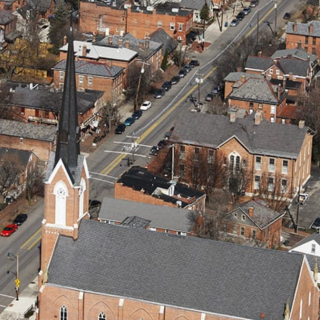“As a fact finder I need to know answers to some of these questions. It’s not going to be sufficient for you today to simply say, ‘somebody else is investigating, I can’t comment.’ Yes you can comment and yes you must,” said Judge Alegon L. Marbley during Wednesday’s (Feb. 24th) hearing.
Attorneys representing protesters in the federal protester lawsuit Alsaada et. Al. vs. City of Columbus questioned former Chief Thomas Quinlan on Wednesday for several hours, asking him who had made final decisions on pepper spraying and firing wooden bullets at protesters during the early days of George Floyd protests downtown.
The lawsuit charges that ineffective training and vague policies resulted in many individual officers to go rogue against mostly peaceful protesters who had the right to assemble and express free speech.
The suit also claims Chief Quinlan failed to offer meaningful orders against using excessive force before the protests and failed to stop the use of excessive force as the protests continued.
But lead plaintiff attorney John Marshall challenged Quinlan on whether decisions to utilize pepper spray and wooden bullets were coming directly from Quinlan’s command center which was monitoring the situation from live video feeds.
“Are you suggesting that during these protests…that somehow your command operation center was in control of all that?” asked Marshall.
Quinlan answered, “What I’m saying is (if) I’m overseeing what’s available by video, I’m relaying directions to the field.”
“Are you suggesting that your command operation center had command over all the different parts of these protests at all times?” asked Marshall.
Quinlan responded, “No, what I’m saying is, they (the command center) only have control (to send) directions to the field, and supervisors, lieutenants and sergeants, give boots on the ground, real-time decision making in the moment.”
US Southern District of Ohio Judge Alegon L. Marbley interjected, asking, “Are you saying that there were three different sources of direction, one from the command center, one from the supervisors on the ground, and one from non-supervisors on the ground?”
Quinlan said ‘No,’ all decisions were made from a “unified command” and that supervisors and officers on the ground were given rules of engagement called “Chief’s Intent,” or what Quinlan expected his officers to do if he wasn’t there to give direction.
Judge Marbley asked again, “Were there instances during the George Floyd protests, where the decision as to whether the protesters were being aggressive were made from the command center?”
Quinlan finally answered “Yes.”
“In those instances, were the officers on the ground given directions from the command center on how to respond to the aggressive activities?” asked Judge Marbley.
Again, Quinlan did not offer a definitive answer. “We’re telling them what we want them to accomplish. If we want someone arrested, or contained, we direct that, and then they carry that out in the safest manner possible.”
Plaintiff attorneys also repeatedly asked the former Chief, after showing multiple videos, whether he believed his officers were violating Division policy by using excessive force against non-aggressive protesters.
Some protesters did cause destruction, threw frozen bottles of water and used fireworks against officers.
Nonetheless, numerous video evidence showed officers pepper spraying protesters without provocation. One video from June 24 showed police, after they demanded protesters to leave the intersection of Broad and High, ramming their bicycles and pepper spraying those protesters who refused to disperse.
Attorney Marshall asked, “Did you see the use of the Mark-9 pepper spray? Obviously someone determined this crowd was being aggressive and therefore being dispersed?”
By this this time Division policy had changed: pepper spray was not to be used to disperse a crowd unless they were being aggressive or violent.
Marshall asked, “Can you tell from the video how they are being aggressive? How would you describe the aggression that you see here?
“Based upon what you see here, was their behavior in compliance with Division policy?”
Again, Quinlan seemed to dodge the question, saying, “It’s clear I can’t answer an opinion without an investigation. I don’t know what prompted that.” He also mentioned the video he was seeing remotely was fragmented and erratic, and that an internal investigation regarding the video is still ongoing.
This is when Judge Marbley halted the questioning, asking the video to be re-shown.
Judge Marbley then continued, “As a fact finder I need to know answers to some of these questions. It’s not going to be sufficient for you today to simply say, ‘somebody else is investigating, I can’t comment.’ Yes you can comment and yes you must…and if you don’t answer it, I’m going to make certain presumptions, and those presumptions probably will not benefit (you) or to the city’s benefit.
“Because in the court’s mind, if you look at something and you can’t tell me this whether this is consistent with departmental policy it will either tell me (one of three things). You don’t understand departmental policy, you don’t understand the question, or you are being evasive. And that’s not consistent with your oath.”
The video was re-played and Judge Marbley asked Quinlan, “Is it permissible on the policy for the use and deployment of chemical spray to spray protesters if they are not acting in an aggressive manner? Is that permissible as a general proposition?”
“No,” said Quinlan.
“Is it permissible if they are acting in a non-violent matter?” asked the Judge.
“No, your honor,” said the former Chief.
The trial is scheduled through this week and into next week. The trial can be accessed by calling 646-749-3112 with the access code 347 407 869.



